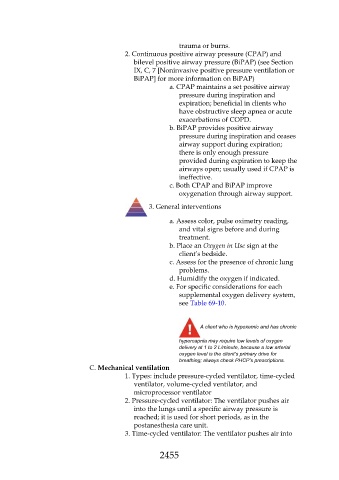Page 2455 - Saunders Comprehensive Review For NCLEX-RN
P. 2455
trauma or burns.
2. Continuous positive airway pressure (CPAP) and
bilevel positive airway pressure (BiPAP) (see Section
IX, C, 7 [Noninvasive positive pressure ventilation or
BiPAP] for more information on BiPAP)
a. CPAP maintains a set positive airway
pressure during inspiration and
expiration; beneficial in clients who
have obstructive sleep apnea or acute
exacerbations of COPD.
b. BiPAP provides positive airway
pressure during inspiration and ceases
airway support during expiration;
there is only enough pressure
provided during expiration to keep the
airways open; usually used if CPAP is
ineffective.
c. Both CPAP and BiPAP improve
oxygenation through airway support.
3. General interventions
a. Assess color, pulse oximetry reading,
and vital signs before and during
treatment.
b. Place an Oxygen in Use sign at the
client’s bedside.
c. Assess for the presence of chronic lung
problems.
d. Humidify the oxygen if indicated.
e. For specific considerations for each
supplemental oxygen delivery system,
see Table 69-10.
A client who is hypoxemic and has chronic
hypercapnia may require low levels of oxygen
delivery at 1 to 2 L/minute, because a low arterial
oxygen level is the client’s primary drive for
breathing; always check PHCP’s prescriptions.
C. Mechanical ventilation
1. Types: include pressure-cycled ventilator, time-cycled
ventilator, volume-cycled ventilator, and
microprocessor ventilator
2. Pressure-cycled ventilator: The ventilator pushes air
into the lungs until a specific airway pressure is
reached; it is used for short periods, as in the
postanesthesia care unit.
3. Time-cycled ventilator: The ventilator pushes air into
2455

